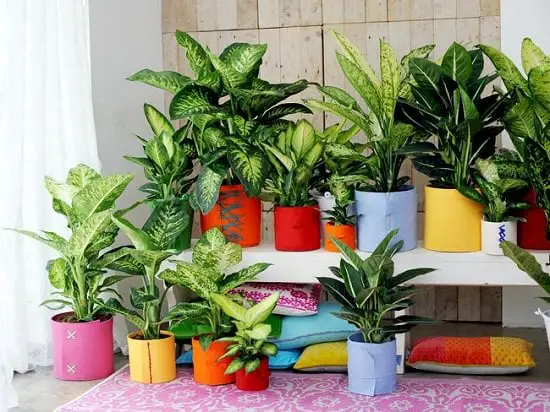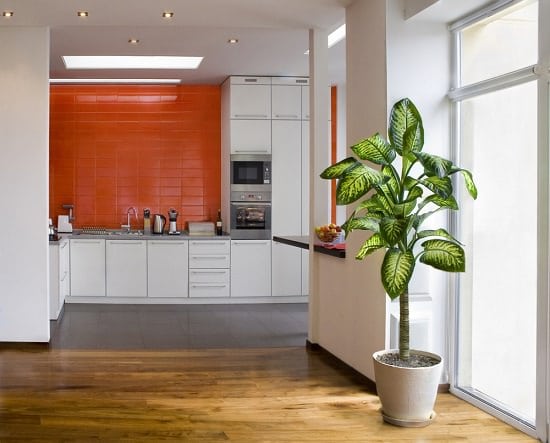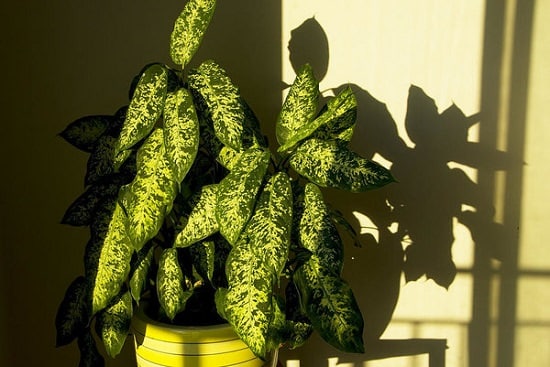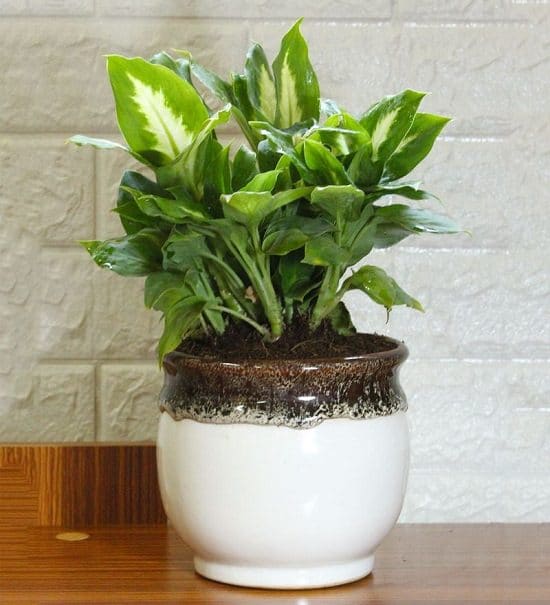Dumb cane is a terrific houseplant to have, and even a novice can grow it! Here’s everything you need to know on How to Care for Dieffenbachia Indoors!

Popularly known as dumb cane, dieffenbachia is a no-fuss plant. The broad and large leaves, with intricate patterns, are showy and give a tropical feel to the place where you plant it. There are many types of dumb canes, and variegation of leaves and plant size depends on the cultivar you’re growing. Let’s know more about How to care for dieffenbachia in this article.
Colors: Green, White, Yellow and Variegated
Features: Air-purifying plant, Low light houseplant, Big foliage indoor plant
Check out our article on Peace Lily care tips here!
Pot Size for Dieffenbachia
Choosing the pot depends on the variety, which you are growing. Large ones, like Dieffenbachia amoena ‘Tropic Snow,’ can reach up to the height of 6 feet and require a pot size of 12-16 inches. Similarly, dwarf varieties like ‘Compacta’ can do well in a small 6-8 inches pot.
Since this houseplant becomes tall and has the ability to adjust in a smaller pot, choose a decorative terracotta pot for the indoor purpose. The heaviness of such a container will save the plant from toppling down if it’ll grow bigger in the smaller pot.
Note: Dieffenbachia grows best in a slightly root bound state.
Dieffenbachia Types
Some of the most popular types of dumb canes you can grow indoors are ‘Carina,’ ‘Compacta,’ ‘Honeydew,’ ‘Sarah,’ ‘Sparkles,’ and ‘Star Bright.’ With their attractive variegated foliage, they are sure to add a lot of appeal to your rooms!
Requirements for Growing Dieffenbachia
Location
A location that receives bright indirect light is nice for growing dieffenbachia indoors. A position with exposure to morning sun like an east-facing window or door is the perfect place. Ensure that you’re using drapes near a south-facing window with full sun.
When growing outdoors, it can be an excellent shade plant–one of the reasons why it’s a popular houseplant. Also, make sure to protect it from cold drafts.
Soil
Well-draining loamy soil, rich in organic matter, is ideal for the dumb cane. Avoid planting it in garden soil. Instead, go for a quality commercial potting mix, you use for other houseplants or DIY it from the recipes here.
Watering
Watering depends on the location and pot size. A plant in a large pot located at a spot with partial sun and gusts of winds may need more frequent watering. In contrast, an average indoor dieffenbachia receiving indirect sunlight and moderate airflow need to dry out between watering spells. This is an important point to consider while taking care of dieffenbachia.
- Thoroughly water the plant and allow the excess water to drain from the drainage holes.
- Make sure that the soil is dry. Poke your index finger to feel the moisture before rewatering again.
- Water needs will be more in summers, as compared to winters and during the rainy days, and it is also going to depend on the climate in your region.
To know more about watering houseplants, click here!
Dieffenbachia Care
Temperature
The average room temperature of 65-75 F (18-24 C) is ideal for the growth of this houseplant. Temperature below 55 F (12 C) causes slow growth, so keep at a warm place. And, don’t consider that a high temperature is going to do any good, as it makes the plant weak and frail.
Humidity
Some cultivars of dieffenbachia do benefit from the raised humidity levels. But most of them don’t show any significant difference when in the high humid surroundings. Moreover, extremely humid conditions can lead to anthracnose fungal disease.
- This houseplant doesn’t mind dry indoor air.
- In case of very low humidity and dry air, use a humidifier.
- If you want to check out other ways to raise the humidity, click here.
Fertilizing
Use a balanced liquid fertilizer like 10-10-10, once in 2-4 weeks. The interval depends on how well your plant is growing, if you see the symptoms of overfertilization, skip the next fertilizing cycle. Ideally, you must feed it while watering, so that it reaches deep in the soil. If the soil lacks nutrients, add fertilizer at the time of planting or even re-potting. This is an important point to consider while taking care of dieffenbachia.
- Fertilize the plant regularly during the growing period.
- If you see a lack of foliage growth, apply high nitrogen fertilizer.
- If the plant is growing in low light, feed it less frequently.
- Avoid feeding the plant in the wintertime.
Pruning
Prune the plant when the stems shed enough leaves to expose the canelike trunk. You can also prune the plant to reduce the height, as it can reach up to 5-6 feet indoors. Use a sharp knife and cut the canes at a 45-degree angle. Do make sure not to cut more than 1/3 of its growth.
Note: Wear gloves while pruning, to be safe from the calcium oxalate crystals that cause itching to throat and mouth.
Pests and Diseases
Always be on a lookout for aphids, scales, and spider mites. If you observe rotting leaf-joint, it may be due to Erwinia bacteria. Discard the plant before it spreads. Anthracnose, a fungal disease, causes brown or black spots and margins to turn brown. Cut off the infected parts and spray neem oil solution over the plant to keep it in check.
Overwatering can cause root rot, which leads to the death of this houseplant. Follow the right watering practice and make sure there are sufficient drainage holes in the bottom of the pot.
Toxicity
Even wondered why it’s known as the dumb cane? Because when chewed upon, it causes swelling of tongue and throat, leading to temporary loss of speech. So keep it out of the reach of pets and curious kids. Although the effect is temporary, it can still cause suffocation, so it’s always better to be safe than sorry!





